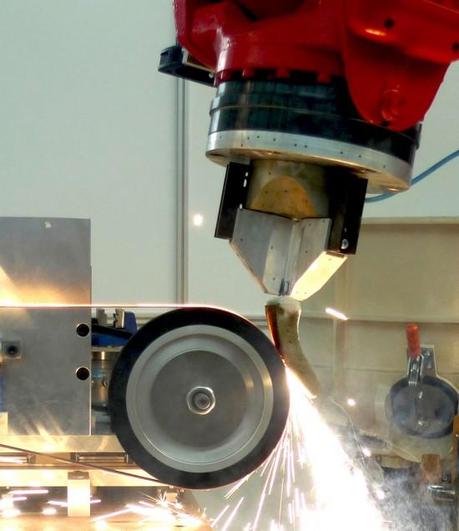
A robot automatically restores the damaged sections of a turbine blade. (Credit: Fraunhofer IWF TU Berlin)
Almost all electrical power on Earth is produced with a turbine of some type. When the turbines get damaged, it is often cheaper to repair them than to buy replacements. However, the repair process is complex and hard to automate. Now a group of engineers from the Berlin Institute of Technology has developed a robot that can repair turbines faster, cheaper, and more precisely than humans.
The German turbomachinery sector is booming. Over the past 25 years, it has doubled its share of the global market from 15 to 30 percent. For manufacturers, the service business—i.e. maintenance, repair, and overhaul (MRO)—is steadily growing in importance. The blades in compressors and turbines are subject to particularly high levels of stress and strain. The job of the blades is to convert fluid energy into mechanical energy. They ensure that aircraft engines generate the required thrust and that power plant generators produce sufficient electricity.
“Damage to the blades of aircraft turbines is caused by wear from vibration and friction, for example, or by erosion from particles of sand and dust. Other triggers are hard landings, when individual engine components come into contact with each other, and large objects striking the engine,” explains Martin Bilz, head of manufacturing technologies at the Fraunhofer Institute for Production Systems and Design Technology IPK in Berlin. In such cases, the geometrically complex components, which are mostly made of titanium- or nickel-alloy steels, bend or crack and the flow of air is no longer optimal. This can cause engine performance to drop and fuel consumption to rise.
Repairing the damaged components makes sound financial sense. Depending on the stage and engine size, a single turbine blade can cost several thousand euros. With an airplane needing up to 80 blades, the costs stack up very quickly for aircraft operators. Repair, however, is over 50% cheaper. The drawback with repair is that the processes involved are very complicated and elaborate. The individual work steps cannot be easily integrated into largely automated series manufacturing. Specialists process the workpieces by hand or with specially adapted machine tools. Depending on its size, it can take anything from a few hours to several days before a single blade is repaired. Or to give another example: on account of the strict quality assurance requirements in the aviation industry, it can often take two to three weeks before an individual rotating engine component can return to action.
Within the Fraunhofer MRO innovation cluster, Fraunhofer IPK and the Institute for Machine Tools and Factory Management IWF of the Technische Universität Berlin set themselves the goal of developing an automated, robot assisted technique. “Whereas machine tools remain consistently expensive, robots are getting cheaper all the time, and now they can even be used for machining tasks,” says Bilz, explaining the institutes’ approach. Lending the researchers support were specialists from turbomachinery manufacturers such as MAN, MTU, Rolls-Royce, and Siemens. Together with further partners from business and research, the IPK not only managed to make individual process steps suitable for automation, they also developed a technique whereby a robot passes through several repair stations inside a single production cell. What is special about this technique is that the robot holds on to the component at all times and moves around to the individual stations in turn, which are arranged around it in an area of about 15 square meters. It cleans the component, measures its geometry, locates the faults, and carries out machining repairs.
“Not only is the robot assisted production cell a good example of a resource conserving and energy-efficient MRO process, it has also opened up new prospects for the manufacture of turbomachine components. For example, it makes the repair of compressor blades faster, cheaper, and more precise. Now we want to see the technology quickly taken up in manufacturing plants ,” explains Bilz. IPK scientists will be exhibiting the technique at the International Paris Air Show at Le Bourget, Paris from June 17 to 23, 2013.
Fraunhofer is driving ahead with further research into this topic with the new “Life Cycle Engineering for Turbomachines” innovation cluster, which was launched at the end of May. Joining the IPK in the cluster are the Fraunhofer Institutes for Reliability and Microintegration IZM in Berlin, for Telecommunications, Heinrich-Hertz-Institut, HHI in Berlin, and for Ceramic Technologies and Systems IKTS in Dresden. Bilz summarizes the cluster’s work as follows: “Our goal is to provide energy-efficient and resource conserving technologies for all turbomachine life cycles. In addition to MRO, we are also taking into account the upstream design and production stages. Our focus is on aircraft engines and gas turbines for power plants.”

